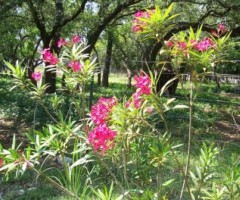

Proper nutrition and management practices
can prevent many problems associated with caring for horses. You can
learn how to provide your horse with a better life-style by taking the online course
"How to Feed for Maximum Performance" taught by Eleanor Richards. Go
to www.horsecoursesonline.com for more information. Contact Eleanor at elrichards@thewayofhorses.com or (440) 554-3714. Be sure to visit Eleanor's web site at www.thewayofhorses.com |
Treat or Threat - Plants By Eleanor Richards Copyright©2007 The symptoms are colic, diarrhea (possibly bloody), sweating, lack of coordination, shallow and difficult breathing, muscle tremors, erratic heart rate…death will follow soon. Do you have oleander plants near your horses? Are your neighbors throwing clippings over your fence after they have pruned ornamentals? Oleander is extremely toxic to horses…even in small amounts. Once ingested virtually nothing will save the horse. Laxatives may help purge the plant from the system and medications may help with the other symptoms, but death is usually the result within 8-24 hours after ingestion. Recognizing poisonous plants and trees, and then taking steps to prevent horses from eating them is high priority. When you plant ornamentals, trees or other types of vegetation do research to determine if they are toxic to horses. Most pastures have some plants that are not edible. And it's fortunate the majority of poisonous plants are unpalatable (they taste bad). Horses receiving adequate nutrition and plenty of good quality forage will usually not voluntarily eat poisonous plants. However, there is a chance poisonous plants may be in the hay (always check hay at each feeding) and ingested by mistake. Horses kept stalled or in a dry lot may eat any green vegetation to which they come in contact. These horses crave something moist and green. The chemical compounds in poisonous plants effect horses in a number of ways. Some of the symptoms mimic other ailments, so unless the horse is observed eating the plant it is hard to determine what is causing the illness. Many times, once the source is identified (if ever), it is too late. Some of the symptoms can be diarrhea (possibly bloody), sweating, lack of coordination, shallow and difficult breathing, muscle tremors, erratic heart rate - such as oleander poisoning. Other signs of poisoning are dullness, depression, aimless wandering, head-pressing, photosensitization causing sunburn of pink-skinned areas, weight loss, bleeding disorders, severe blistering of the mucous membranes lining the entire gastrointestinal tract, dilated pupils, liver damage and jaundice of mucus membranes. The type of symptoms the horse presents depends on the type of plant the horse has ingested. It is also possible the horse will be found dead with no previous apparent symptoms. There are many books and web sites to help identify poisonous plants. Your local cooperative extension office is a great source. One web page I like is published by the Purdue University of School of Veterinary Medicine. It can be found at: http://www.vet.purdue.edu/depts/addl/toxic/by_alpha.htm Take a look around and see if you can identify the oleander plant. It is has thick elongated lance-shaped leaves which can grow up to 10 inches in length. The flowers grow at the end of the branches in clusters. The shrub will produce white, pink or red blossoms. It can be a small shrub or up to the size of a small tree. Not every plant is a treat for a horse…some are a threat! Copyright©thewayofhorses Eleanor Richards |
